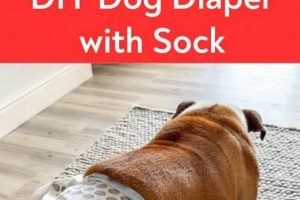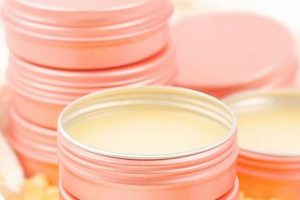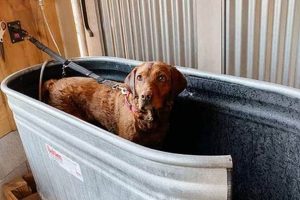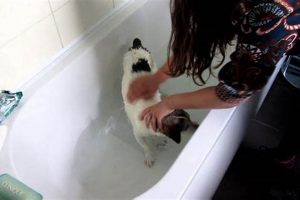The formulation of canine cleansing agents at home, specifically designed to alleviate dermal irritation, represents a practical approach to pet hygiene. These homemade solutions offer an alternative to commercially produced products, potentially mitigating allergic reactions or sensitivities some dogs may experience with conventional ingredients. For example, a blend of finely ground oatmeal, distilled water, and a small amount of hypoallergenic dish soap can create a gentle, soothing wash.
The significance of preparing these solutions stems from the ability to precisely control the components, ensuring the absence of harsh chemicals or fragrances often found in mass-market options. This targeted approach can be particularly beneficial for animals suffering from conditions such as atopic dermatitis or flea allergy dermatitis, where minimizing irritants is paramount. Historically, pet owners have sought natural remedies for their animals’ ailments, and the practice of creating customized grooming products continues this tradition, often resulting in cost savings and improved pet comfort.
The following sections will delve into specific ingredients commonly used in these formulations, detailing their properties and appropriate application. Furthermore, it will address the importance of patch testing and consulting with a veterinarian prior to implementing a homemade cleansing regimen. Guidelines for proper mixing and storage will also be provided to ensure product efficacy and safety.
Guidance for Crafting Canine Cleansing Solutions to Alleviate Dermal Irritation
The subsequent guidelines offer essential considerations for individuals seeking to formulate homemade canine cleansing agents designed to soothe itchy skin. Adherence to these principles ensures both the efficacy and safety of the resultant product.
Tip 1: Ingredient Selection: Prioritize hypoallergenic and non-irritating substances. Colloidal oatmeal, known for its soothing properties, is a beneficial addition. Consider incorporating aloe vera gel for its anti-inflammatory effects. Avoid harsh detergents and artificial fragrances.
Tip 2: Dilution is Crucial: Concentrated cleansing agents, even those deemed gentle, can exacerbate irritation if applied directly. Always dilute the solution with water to achieve a mild concentration. A general guideline is a 1:10 ratio of cleansing agent to water, but adjustments may be necessary based on ingredient potency.
Tip 3: Conduct a Patch Test: Prior to full-body application, perform a patch test on a small, inconspicuous area of the dog’s skin. Observe the area for 24-48 hours, noting any signs of irritation, redness, or discomfort. Discontinue use immediately if adverse reactions occur.
Tip 4: Water Temperature: Use lukewarm water for bathing. Excessively hot or cold water can further irritate sensitive skin. Ensure thorough rinsing to remove all traces of the cleansing agent.
Tip 5: Frequency of Use: Over-bathing can strip the skin of natural oils, leading to increased dryness and irritation. Limit bathing to as-needed basis, typically no more than once every two to four weeks, unless otherwise directed by a veterinarian.
Tip 6: Consultation with a Veterinary Professional: Before implementing a homemade cleansing regimen, consult with a veterinarian. The veterinarian can assess the underlying cause of the itching and provide tailored recommendations for treatment and skincare.
Tip 7: Proper Storage: Store the prepared cleansing solution in a clean, airtight container in a cool, dark place. Discard any unused solution after one week to prevent bacterial growth.
Adherence to these recommendations promotes the safe and effective use of homemade canine cleansing solutions designed to alleviate dermal irritation. Prioritizing gentle ingredients, proper dilution, and veterinary consultation ensures the well-being of the animal.
The following section will address potential risks and complications associated with creating and using these homemade solutions, further emphasizing the importance of caution and professional guidance.
1. Gentle ingredients.
The selection of mild, non-irritating components constitutes a foundational principle in the formulation of homemade canine cleansing agents designed to alleviate dermal discomfort. In the context of creating “dog shampoo for itchy skin diy,” the term “gentle ingredients” directly influences the product’s ability to soothe irritated skin rather than exacerbate the condition. Ingredients like colloidal oatmeal, chamomile, or aloe vera possess inherent anti-inflammatory and moisturizing properties, which can help reduce itching and promote skin healing. Conversely, harsh detergents, sulfates, or artificial fragrances can strip the skin of its natural oils, leading to increased dryness and intensified pruritus. For instance, a commercially available shampoo containing sodium lauryl sulfate might alleviate surface dirt but simultaneously trigger an allergic reaction in a dog with sensitive skin, thus negating the intended benefit.
The implementation of gentle ingredients extends beyond simply avoiding harsh chemicals; it necessitates a nuanced understanding of a dog’s specific skin sensitivities. What may be considered gentle for one canine may prove irritating for another. Therefore, a degree of experimentation, guided by veterinary advice, is often required to identify the most suitable combination of components. For instance, a blend of distilled water, finely ground oatmeal, and a minimal amount of unscented castile soap could provide effective relief for a dog with mild dermatitis, while a more severe case might require the addition of an emollient like coconut oil, known for its moisturizing capabilities. The cause and effect relationship is clear: gentle ingredients yield soothing effects, while harsh ingredients can worsen the condition.
In summary, the selection of “gentle ingredients” is not merely a suggestion but a critical requirement for successful “dog shampoo for itchy skin diy.” It dictates the effectiveness and safety of the homemade solution. A thorough understanding of ingredient properties, coupled with careful observation and veterinary guidance, is essential to mitigate the risk of adverse reactions and maximize the potential for relieving canine dermal irritation. Challenges may arise in identifying specific allergens or sensitivities, underscoring the ongoing need for attentive monitoring and iterative refinement of the shampoo formulation.
2. Proper dilution.
The phrase “Proper dilution” holds paramount importance in the context of creating “dog shampoo for itchy skin diy.” It directly affects the efficacy and safety of the homemade cleansing solution. Failure to dilute ingredients adequately can result in concentrated substances irritating the canine epidermis, thereby exacerbating the initial condition. A potent undiluted agent, even one with otherwise beneficial properties, can cause chemical burns or severe allergic reactions. The cause-and-effect relationship is evident: insufficient dilution leads to increased skin irritation, while appropriate dilution mitigates this risk. Proper dilution transforms a potentially harmful substance into a therapeutic one. Dilution ensures even distribution of the active ingredients across the coat and skin, maximizing their soothing and cleansing effects while minimizing the potential for localized irritation or toxic reactions.
The practical application of this understanding manifests in precise mixing ratios. For example, if using castile soap, a common ingredient in homemade canine shampoos, a dilution of 1:10 (soap to water) is often recommended as a starting point. For dogs with exceptionally sensitive skin, a further dilution to 1:15 or 1:20 may be necessary. The appropriate dilution ratio hinges on the individual dog’s sensitivity, the concentration of the chosen ingredients, and the severity of the skin condition. Proper dilution, therefore, cannot be a one-size-fits-all approach. It requires careful observation and adjustment. For instance, a user might notice redness or increased scratching after the initial wash, indicating the need for greater dilution in subsequent applications.
In conclusion, “Proper dilution” is not merely a procedural step but a crucial determinant of success in “dog shampoo for itchy skin diy.” Overlooking its importance can render the homemade solution counterproductive, potentially harming the animal it intends to help. Challenges may involve accurately assessing ingredient concentrations and recognizing subtle signs of skin irritation. Consistent attention to dilution ratios, guided by veterinary advice and attentive observation, is paramount for ensuring a safe and effective outcome. The ultimate goal is to create a cleansing solution that soothes and heals, not one that contributes to further epidermal damage.
3. Veterinarian consultation.
Veterinary consultation represents a critical safeguard when considering a “dog shampoo for itchy skin diy” approach. Due to the complex and varied etiologies of canine pruritus, a professional diagnosis is paramount for ensuring the efficacy and safety of any homemade remedy. A generalized approach to managing itchy skin may prove ineffective or even detrimental without identifying the underlying cause.
- Diagnosis of Underlying Conditions
Veterinarians possess the expertise to differentiate between various dermatological conditions, such as allergies, parasitic infestations (e.g., mites, fleas), bacterial or fungal infections, and autoimmune diseases. An accurate diagnosis is essential because each condition requires specific treatments that a homemade shampoo alone cannot provide. For instance, a dog experiencing pruritus due to a yeast infection necessitates antifungal medication, while a homemade shampoo designed for allergies may be ineffective and delay appropriate treatment. A misdiagnosis, consequently, can lead to prolonged suffering and potential complications.
- Identification of Allergens and Irritants
A veterinarian can perform allergy testing (e.g., intradermal skin testing, serum allergy testing) to identify specific allergens triggering the dog’s immune response. This information is invaluable in selecting appropriate ingredients for a homemade shampoo, ensuring it avoids known irritants. For example, a dog allergic to oats should not be bathed with a homemade shampoo containing colloidal oatmeal. Without allergy testing, owners may inadvertently incorporate allergens into the shampoo, exacerbating the dog’s condition. Veterinarians can also help identify environmental irritants and recommend modifications to the dog’s environment to minimize exposure.
- Assessment of Skin Integrity and Concurrent Medical Conditions
Prior to using any shampoo, a veterinarian should assess the overall health of the dog’s skin. The presence of open wounds, secondary infections, or other dermatological abnormalities may contraindicate the use of certain ingredients or necessitate a specific treatment protocol. Furthermore, concurrent medical conditions, such as hypothyroidism or Cushing’s disease, can contribute to pruritus and require management beyond topical treatments. A veterinarian can provide guidance on how to manage these conditions in conjunction with a homemade shampoo, ensuring a holistic approach to the dog’s health.
- Guidance on Appropriate Ingredients and Formulations
While numerous online resources offer recipes for homemade dog shampoos, a veterinarian can provide evidence-based recommendations regarding the safety and efficacy of specific ingredients. They can advise on appropriate concentrations, potential interactions between ingredients, and any contraindications based on the dog’s medical history. For example, a veterinarian may recommend against using tea tree oil in a homemade shampoo due to its potential toxicity to dogs. Furthermore, they can assess the pH balance of the shampoo and recommend adjustments to ensure it is compatible with the dog’s skin. This professional guidance minimizes the risk of adverse reactions and maximizes the potential benefits of the homemade shampoo.
In summary, seeking veterinary consultation before embarking on a “dog shampoo for itchy skin diy” endeavor is essential for ensuring the dog’s safety and well-being. Veterinarians can provide an accurate diagnosis, identify allergens, assess skin integrity, and offer evidence-based guidance on appropriate ingredients and formulations. This collaborative approach optimizes the potential for successful management of canine pruritus while minimizing the risk of adverse outcomes.
4. Skin pH balance.
Maintaining the appropriate epidermal pH is a critical consideration in the formulation of homemade canine cleansing agents designed to alleviate dermal irritation. Disruptions to the natural acidity of the skin can compromise its barrier function, leading to increased susceptibility to infection, inflammation, and exacerbated pruritus. Understanding the nuanced relationship between pH and canine skin health is paramount for effective “dog shampoo for itchy skin diy.”
- Canine Skin Acidity
Canine skin, unlike human skin, is typically more alkaline, with a pH ranging from 5.5 to 7.5. This higher pH renders canine skin more vulnerable to bacterial colonization and environmental irritants. Cleansing agents with excessively alkaline pH levels can further disrupt the skin’s acid mantle, compromising its protective barrier function. Conversely, solutions that are too acidic can also cause irritation. The maintenance of a pH-balanced environment is crucial for preserving epidermal health and resilience.
- Impact of pH-Imbalanced Shampoos
The use of shampoos formulated for human use, or homemade solutions with improperly balanced pH levels, can disrupt the canine skin’s natural acidity. This disruption can lead to a cascade of negative effects, including increased dryness, itching, and susceptibility to secondary infections. The compromised barrier function allows for greater penetration of allergens and irritants, exacerbating existing skin conditions. Therefore, the selection of pH-appropriate ingredients is a prerequisite for effective “dog shampoo for itchy skin diy.”
- Ingredients and pH Modulation
Certain ingredients commonly used in homemade canine shampoos can significantly influence the pH of the final product. For instance, castile soap, while often touted as a gentle cleanser, typically exhibits an alkaline pH. The addition of acidic substances, such as apple cider vinegar or lemon juice, may be employed to lower the pH and bring it closer to the optimal range for canine skin. However, the use of these ingredients requires careful monitoring and testing to avoid over-acidification, which can also cause irritation. pH testing strips provide a simple method for assessing and adjusting the pH of homemade solutions.
- Importance of Professional Guidance
Given the complexity of pH balance and its potential impact on canine skin health, consultation with a veterinarian is highly recommended before embarking on “dog shampoo for itchy skin diy.” A veterinarian can assess the dog’s specific skin condition, provide guidance on appropriate pH ranges, and recommend ingredients that are both effective and safe. Furthermore, they can advise on the frequency of bathing and other skincare practices to maintain optimal epidermal health. Professional guidance minimizes the risk of adverse reactions and maximizes the potential benefits of homemade cleansing agents.
The interplay between epidermal pH and canine skin health underscores the importance of careful ingredient selection and formulation techniques in “dog shampoo for itchy skin diy.” The goal is to create a cleansing solution that effectively removes dirt and debris while preserving the skin’s natural barrier function and promoting a healthy microbial environment. The proactive management of pH, informed by scientific principles and veterinary guidance, is a critical component of responsible pet skincare. Failing to address pH balance can result in unforeseen complications, negating the intended benefits of the homemade shampoo and potentially exacerbating pre-existing skin conditions.
5. Avoid harsh chemicals.
The directive to “Avoid harsh chemicals” forms a cornerstone of responsible “dog shampoo for itchy skin diy.” The presence of potent synthetic compounds can negate the therapeutic intent, leading to exacerbation of dermal irritation and potential systemic effects. Diligent avoidance of such substances is therefore crucial for creating safe and effective homemade cleansing solutions.
- Sulfates and Their Irritant Potential
Sulfates, such as sodium lauryl sulfate (SLS) and sodium laureth sulfate (SLES), are common surfactants used for their foaming and cleansing properties. However, these compounds are known irritants, capable of stripping the skin of its natural oils and disrupting the epidermal barrier. In the context of “dog shampoo for itchy skin diy,” the inclusion of sulfates can intensify dryness and itching, particularly in dogs with sensitive skin or pre-existing dermatological conditions. A practical example is a dog with atopic dermatitis experiencing increased flare-ups after being washed with a sulfate-containing shampoo. The implication is a need for sulfate-free alternatives.
- Artificial Fragrances and Allergic Reactions
Artificial fragrances, often composed of complex mixtures of synthetic compounds, represent a significant source of allergic reactions in dogs. These fragrances can trigger contact dermatitis, leading to pruritus, erythema, and even secondary infections. In “dog shampoo for itchy skin diy,” the incorporation of artificial fragrances introduces an unnecessary risk of adverse reactions. Consider a dog developing hives and intense itching after exposure to a shampoo containing artificial floral scents. The necessity to avoid artificial fragrances in homemade formulations becomes apparent.
- Parabens as Endocrine Disruptors
Parabens, a class of preservatives used to inhibit microbial growth, have been identified as potential endocrine disruptors. While their effects on canine health are still under investigation, concerns exist regarding their ability to interfere with hormonal function. In the realm of “dog shampoo for itchy skin diy,” choosing paraben-free alternatives minimizes the potential for long-term health consequences. The long-term implications remain to be determined with complete certainty, but paraben exposure is generally discouraged given potential risks.
- Phthalates and Their Potential Systemic Effects
Phthalates, often used as plasticizers and fragrance stabilizers, have been linked to various health concerns, including endocrine disruption and reproductive toxicity. Although the precise mechanisms and extent of their effects on dogs are not fully understood, avoiding phthalates in “dog shampoo for itchy skin diy” represents a prudent approach. These are generally avoided when alternative ingredients are available.
The interconnectedness of these considerations highlights the importance of meticulous ingredient selection in “dog shampoo for itchy skin diy.” Avoiding harsh chemicals is not simply a matter of replacing one ingredient with another; it requires a comprehensive understanding of potential irritants, allergens, and endocrine disruptors. A mindful approach to ingredient selection, coupled with thorough research and veterinary consultation, is crucial for creating safe and effective homemade canine cleansing solutions.
6. Safe storage.
Appropriate preservation methods are integral to ensuring the sustained quality and safety of homemade canine cleansing solutions. Within the framework of “dog shampoo for itchy skin diy,” the phrase “Safe storage” encompasses a series of practices aimed at preventing product degradation, contamination, and potential harm to the animal.
- Microbial Contamination Prevention
Homemade formulations, lacking the robust preservatives found in commercial products, are particularly susceptible to microbial growth. Bacterial or fungal proliferation can render the shampoo ineffective or, worse, pathogenic. Storing the solution in a clean, airtight container reduces exposure to airborne microorganisms. Furthermore, refrigeration can inhibit microbial activity, extending the product’s shelf life. For example, a batch of homemade shampoo left at room temperature for an extended period could develop a bacterial overgrowth, potentially leading to skin infections upon application.
- Ingredient Degradation Mitigation
Certain natural ingredients, such as essential oils or plant-based extracts, are prone to degradation when exposed to light, heat, or air. Degradation can diminish their therapeutic efficacy or even transform them into irritants. Storing the shampoo in a dark, cool environment, such as a closed cabinet or refrigerator, minimizes these effects. An instance of this could be essential oils losing their therapeutic properties, or developing harmful breakdown products from exposure to sunlight.
- Container Material Compatibility
The choice of storage container can impact the stability of the shampoo. Certain materials may react with specific ingredients, leading to leaching or product degradation. Glass or food-grade plastic containers are generally preferred over reactive metals. For instance, storing an acidic shampoo in a metal container could result in corrosion and contamination. It is important that safe practices are followed to avoid adverse events.
- Child and Pet Safety
Proper storage also extends to preventing accidental ingestion or misuse by children or other animals. Keeping the shampoo in a securely sealed container, stored out of reach, is essential. Furthermore, clear labeling is critical to avoid confusion with other household products. A homemade shampoo, inadvertently consumed, could cause gastrointestinal distress or toxicity depending on the ingredients. The correct storage avoids adverse effects.
These considerations collectively highlight the crucial role of “Safe storage” in the context of “dog shampoo for itchy skin diy.” Neglecting proper preservation methods can compromise product integrity, diminish therapeutic benefits, and potentially endanger the animal. Therefore, a proactive approach to storage, incorporating appropriate containers, environmental controls, and safety measures, is indispensable for ensuring the safe and effective use of homemade canine cleansing solutions.
7. Patch testing.
Patch testing constitutes an indispensable safety measure when formulating canine cleansing solutions at home. In the context of “dog shampoo for itchy skin diy,” it functions as a preemptive assessment of potential adverse reactions to individual ingredients or the final product. This practice involves applying a small amount of the solution to a discreet area of the dog’s skin and observing for any signs of irritation, such as redness, swelling, itching, or blistering, over a period of 24 to 48 hours. The underlying principle is to identify sensitivities before widespread application, thereby mitigating the risk of a severe allergic reaction across the animal’s entire body. For instance, an individual might incorporate lavender essential oil, known for its purported soothing properties, into a homemade shampoo. However, some dogs may exhibit sensitivity to lavender, resulting in contact dermatitis. Patch testing provides a means to detect such sensitivities before the entire coat is exposed. This contrasts sharply with a scenario where the shampoo is used without prior testing, potentially leading to widespread inflammation and discomfort.
The practical application of patch testing involves selecting a relatively hairless area, such as the inner thigh or abdomen, applying a small quantity of the prepared shampoo, and covering the area with a breathable bandage or cloth to prevent the dog from licking it. Careful observation is then required over the subsequent 48 hours. The absence of any adverse reaction indicates a lower likelihood of a widespread allergic response, though it does not guarantee complete safety. Conversely, any sign of irritation necessitates immediate discontinuation of the ingredient or formulation. Furthermore, patch testing should be conducted for each new ingredient introduced into the shampoo recipe, even if the dog has previously tolerated other components of the formula. For example, a change in the source or grade of colloidal oatmeal could introduce new allergens or irritants, requiring a fresh patch test. A dog who normally tolerates oatmeal experiencing a reaction to a particular oatmeal source provides a very clear case for vigilance through proper product testing.
In summary, patch testing is not merely a recommended precaution but an essential component of responsible “dog shampoo for itchy skin diy.” It offers a proactive means of identifying potential allergens or irritants before widespread application, thereby minimizing the risk of adverse reactions and maximizing the safety of homemade canine cleansing solutions. Challenges may arise in accurately interpreting subtle signs of irritation or ensuring consistent application techniques. However, the benefits of patch testing far outweigh the potential difficulties, underscoring its importance in safeguarding canine health and well-being.
Frequently Asked Questions
The following addresses common inquiries regarding the formulation and application of homemade canine cleansing agents designed to soothe pruritic conditions. These responses aim to provide clarity and guidance based on established dermatological principles and best practices.
Question 1: Is “dog shampoo for itchy skin diy” inherently safer than commercially available options?
Not necessarily. While homemade formulations offer control over ingredient selection, they lack the rigorous testing and standardization of commercial products. The absence of preservatives also increases the risk of microbial contamination. Safety depends entirely on proper formulation, handling, and storage.
Question 2: Can “dog shampoo for itchy skin diy” cure chronic skin conditions?
Homemade cleansing solutions primarily provide symptomatic relief. They do not address the underlying causes of chronic dermatological conditions such as atopic dermatitis or food allergies. Veterinary intervention is essential for diagnosis and management of these conditions.
Question 3: What are the essential ingredients in “dog shampoo for itchy skin diy” for optimal results?
There is no single “essential” ingredient. However, commonly used components include colloidal oatmeal for its soothing properties, aloe vera for its anti-inflammatory effects, and mild, unscented castile soap for cleansing. The specific combination should be tailored to the individual dog’s needs and sensitivities.
Question 4: How often should “dog shampoo for itchy skin diy” be used?
Over-bathing can exacerbate dry skin and irritation. Bathing frequency should be kept to a minimum, typically no more than once every two to four weeks, unless otherwise directed by a veterinarian. Observe the dog’s skin for any signs of dryness or irritation after each bath and adjust the frequency accordingly.
Question 5: Can essential oils be safely incorporated into “dog shampoo for itchy skin diy”?
Essential oils require extreme caution due to their concentrated nature and potential toxicity to dogs. Many are contraindicated. If considering their use, consult a veterinarian experienced in aromatherapy to determine appropriate dilutions and safe options. Improper use can lead to severe adverse reactions.
Question 6: What are the warning signs that “dog shampoo for itchy skin diy” is causing harm?
Signs of adverse reactions include increased itching, redness, swelling, hives, hair loss, or changes in behavior. Discontinue use immediately and consult a veterinarian if any of these symptoms occur.
The formulation of effective and safe homemade canine cleansing solutions requires careful consideration of individual sensitivities, proper ingredient selection, and adherence to stringent safety protocols. Veterinary consultation remains a prerequisite for responsible pet care.
The subsequent section will address advanced techniques in preparing specialized cleansing agents for specific dermatological conditions, further emphasizing the importance of professional guidance.
Concluding Remarks
The preceding exploration of “dog shampoo for itchy skin diy” has underscored the importance of informed decision-making in addressing canine dermal irritation. From ingredient selection and proper dilution to veterinary consultation and safe storage, each element significantly contributes to the efficacy and safety of homemade cleansing solutions. The information presented serves as a guide for those considering this approach, emphasizing that responsible formulation requires a thorough understanding of canine physiology and potential risks.
Ultimately, the decision to pursue “dog shampoo for itchy skin diy” should not be taken lightly. It necessitates a commitment to meticulous research, careful execution, and ongoing monitoring. While the potential benefits of customized care are evident, the importance of professional veterinary guidance cannot be overstated. The long-term well-being of the animal remains the paramount concern, demanding a judicious and informed approach to dermal management.







